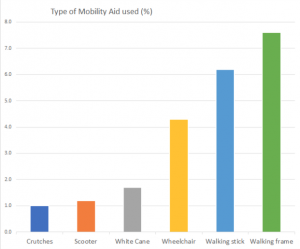In 2018, 17.7% of the Australian population or 4.4 million people had some form of disability, according to the 2016 Australian Bureau of Statistics findings. Almost 50% of persons with disabilities employ an aid to help them with their daily activities. These aids and equipment help them improve their independence and increase their mobility and participation in social or work environments.
The 2016 Census reports that 4.3% of persons who use a mobility aid are reliant on wheelchairs.
Ensuring people with disabilities can easily access doors and doorway entrances promotes an inclusive atmosphere and helps people with disability navigate and mobilise themselves with ease independently. Now how do you make sure doorways are wheelchair accessible? Let us list down the measurements.

The minimum wheelchair door width Australian Standards is 850mm. The doorway must be unobstructed to give enough room for the wheelchair user to approach the doorway, negotiate any turns, unlock and unlatch the door and pass through the doorway. This width is just enough for an A90 (90th percentile wheelchair) to pass through. The Australian Standard also nominates the minimum circulation at doorway requirements to be achieved for bothe swing and sliding doors.
Wheelchair Width
As for wheelchairs, the standard adult-sized mobility aids will have at least 800mm and a length of 1300mm width.
Wheelchair Door Size
In Australia the standard door width is 820 mm however, this standard falls a couple of millimeters short of the recommended wheelchair access width of 850 mm. So it’s best to go for the wider 870mm or 920mm doors to allow wheelchair users easy access.
Door Handle
Regardless of the door size you choose, door handles are all made to comply with AS 1428.1. Door handles should be placed within 900mm to 1100mm above the floor. For a person sitting in a wheelchair, the handle is within easy reach. The handle should be a lever handle where the end of the lever has a return or alternatively a ‘D’ handle. The door handle must also be easy to turn and must not require more force than necessary. Doors fitted with door closers (other than fire rated doors) must be able to be operated with a maximum 20N force.
Door Clearance
As the door is opened, door clearance should also be considered, ensuring there is no obstruction for the door to complete a 90-degree turn or more.
Custom Doors
While custom doors may not follow the Australian standard door sizes or widths, they are sure to go above rather than below the recommended requirements. Auto Doors or door release buttons for opening doors are also very much preferred especially for doorways used by the young or the elderly. One further step towards eliminating physical exertion is to use automatic doors, especially for buildings accessible to the general public is encouraged.
You can finally get your measuring tape to see whether your door allows for wheelchair access. Better yet, if you’re still in the planning stages of building your property, get in touch with your iAccess Consultants for a quick consultation on building accessibility and inclusivity for all!